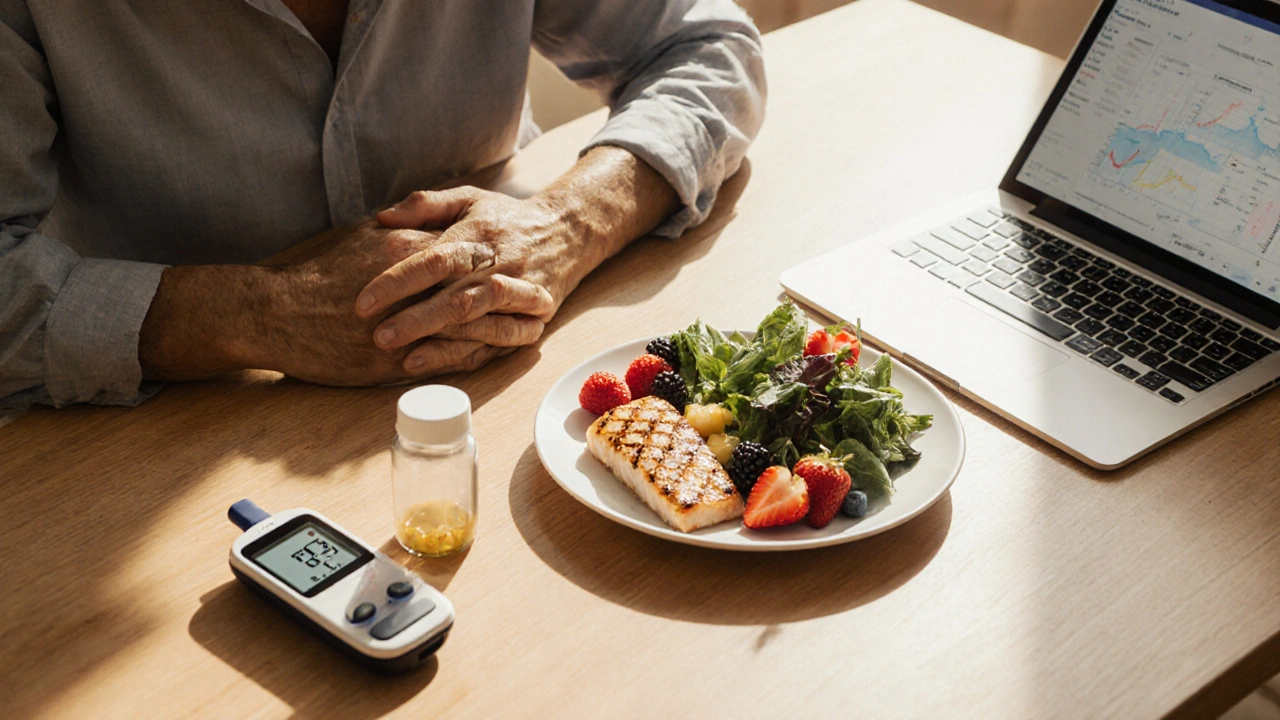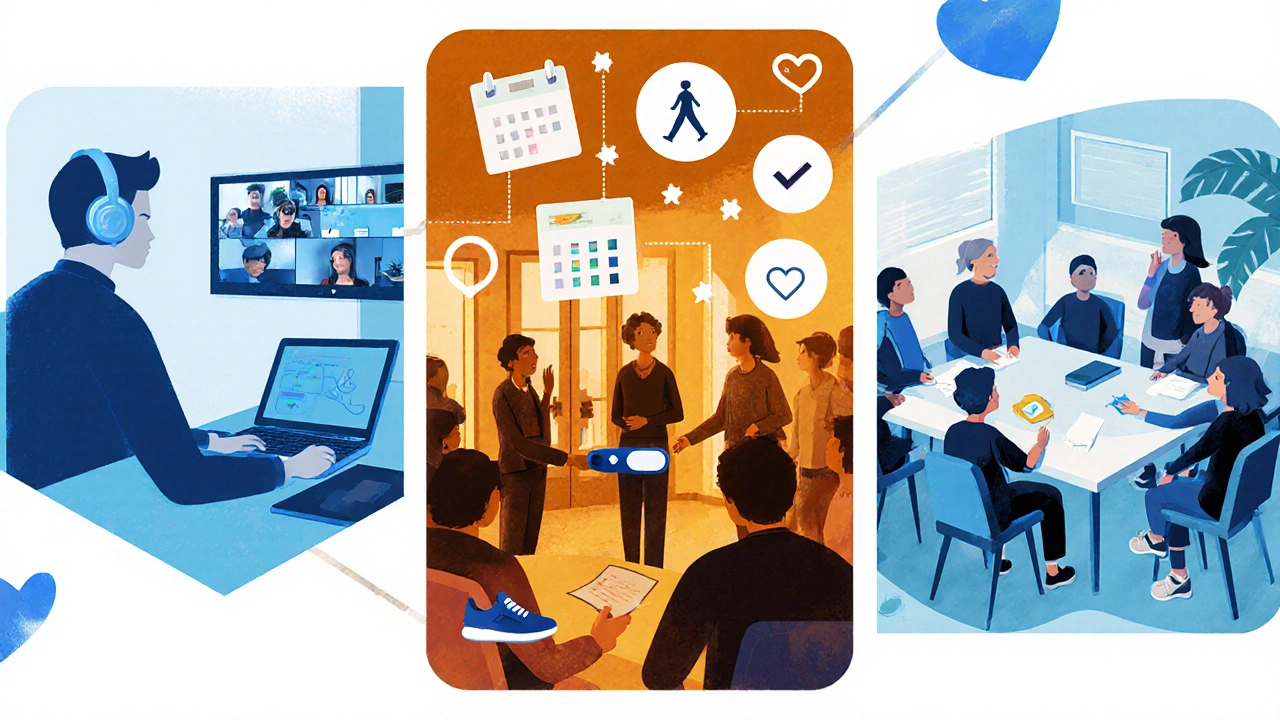How Support Groups Help Manage Type 2 Diabetes
 Oct, 13 2025
Oct, 13 2025
Blood Sugar Tracker & Support Group Tool
Track Your Blood Sugar Levels
Your Progress
How Support Groups Help
Research shows that support groups can help improve glycemic control. As mentioned in the article, participants in a peer-support program reduced their average fasting glucose by 0.6 mmol/L over six months.
By tracking your readings in this tool, you'll be better prepared to share insights with your support group. Your data can help you identify patterns and set measurable goals for your next meeting.
Key Takeaways
- Support groups provide emotional, informational, and practical help that improves blood‑sugar control.
- Peer interaction boosts motivation for lifestyle changes and adherence to medication.
- Different formats-face‑to‑face, virtual, or hybrid-fit varied schedules and comfort levels.
- Effective groups include a diabetes educator, clear goal‑setting, and regular monitoring.
- Choosing the right group involves checking credentials, size, and meeting style.
Why Type 2 Diabetes Needs More Than Pills
Living with type 2 diabetes means juggling diet, exercise, medication, and constant blood‑glucose checks. In 2024, the Australian Diabetes Society reported that over 1.2million Australians have type2 diabetes, and almost half struggle to keep their A1C below 7%.
Numbers alone don’t capture the daily stress of figuring out what to eat, when to move, and how to handle a high reading at work. That’s where a community of people walking the same road becomes a game‑changer.
What Is a Support Group?
Support group is a regular gathering of individuals who share a common health condition and exchange experiences, advice, and encouragement. When the focus is on type2 diabetes, the group often blends personal stories with proven strategies for blood‑sugar control.
Unlike a clinical appointment, a support group is peer‑led or co‑facilitated, which makes the conversation feel less like a lecture and more like a coffee chat with friends who get your challenges.

How Peer Support Improves Blood Sugar Control
Research from the University of Sydney in 2023 showed that participants who attended a peer‑support program for six months reduced their average fasting glucose by 0.6mmol/L compared with a control group.
Three mechanisms drive that effect:
- Accountability - Knowing you’ll share your weekly food log with the group keeps you honest.
- Practical tips - Members swap low‑glycemic recipes, grocery store hacks, and ways to fit activity into a busy day.
- Emotional relief - Talking about frustrations lowers cortisol, a hormone that can spike blood sugar.
All of these boost glycemic control the ability to keep blood‑glucose levels within target ranges, which directly reduces the risk of complications.
Core Tools Shared in Diabetes Support Groups
Most groups cover a handful of essential tools that turn vague intentions into measurable actions.
- Blood glucose monitoring regular checking of blood‑sugar using a meter or continuous sensor - members compare trends, not just single numbers.
- Nutrition counseling guidance from a qualified dietitian on balancing carbs, proteins, and fats - often delivered via a live demo or recipe swap.
- Lifestyle modification structured changes in diet, activity, sleep, and stress management - groups set weekly step goals or walking challenges.
- A1C test a laboratory measurement of average blood glucose over the past 2‑3 months - used as a quarterly checkpoint.
When a diabetes educator a certified professional who teaches self‑management skills or a community health worker a local liaison who connects patients to resources joins the session, the information becomes clinically sound without losing the friendly vibe.
Choosing the Right Format
Not everyone can drive to a community centre after work, and some people feel more comfortable behind a screen. Below is a quick comparison of the three most common formats.
| Format | Typical Size | Frequency | Key Benefits | Potential Drawbacks |
|---|---|---|---|---|
| In‑person | 6‑12 members | Weekly or bi‑weekly | Hands‑on activities, real‑time body‑language cues | Travel time, limited to local area |
| Online (video) | 10‑20 members | Weekly | Convenient, can join from anywhere, recordings available | Screen fatigue, less personal connection |
| Hybrid | Mixed (in‑room + virtual) | Bi‑weekly | Flexibility, broader network, can switch modes | Requires good tech setup, may feel split focus |
Pick the style that matches your schedule, tech comfort, and desire for face‑to‑face interaction.
What Makes a Group Effective?
Based on dozens of Australian community programs, the following ingredients repeatedly show up in high‑performing groups:
- Clear agenda - each meeting starts with a goal (e.g., “reduce evening snacking”).
- Qualified facilitator - a diabetes educator or trained peer leader keeps discussion on track and corrects myths.
- Data‑driven feedback - members bring logs of glucose readings, step counts, or food diaries to review.
- Actionable takeaways - every session ends with 1‑2 concrete steps for the next week.
- Supportive culture - language is non‑judgmental; successes are celebrated, setbacks are treated as learning moments.
When these elements click, participants often report feeling more confident about medication timing, choosing carbs, and handling stress at work.

How to Find or Start a Group
- Search local health‑service websites (e.g., SA Health, Diabetes Australia) for “support group” listings.
- Check social platforms - Facebook has many private “Type 2 Diabetes Adelaide” groups that meet virtually.
- Ask your GP or diabetes educator; they often know community‑run sessions.
- If nothing fits, gather 4‑6 people you know with diabetes and pick a neutral venue (library, community hall).
- Invite a qualified facilitator for the first meeting - many dietitians offer a free introductory session.
Starting your own circle can be as simple as sending a quick email with a proposed date, time, and what you hope to achieve (e.g., “share low‑GI dinner ideas”).
Common Challenges and How to Overcome Them
Attendance drops after a few weeks. Offer a rotating leadership model so members feel ownership, and send reminder texts the day before.
Members share inaccurate information. Have a facilitator who can gently correct myths and provide links to reputable sources such as Diabetes Australia.
Scheduling conflicts. Alternate meeting times (morning, evening, weekend) or switch to hybrid mode to give members flexibility.
Emotional overload. Incorporate a short mindfulness or breathing exercise at the start to set a calm tone.
Next Steps for Readers
If you’re ready to give a support group a try, start by listing three personal goals for the next month - maybe “track carbs for two weeks” or “walk 5km total each week.” Then locate a group that aligns with those goals using the checklist above. Bring your glucose log to the first meeting; you’ll be surprised how quickly the shared insights start moving the numbers.
Frequently Asked Questions
Do I need a doctor’s referral to join a diabetes support group?
No, most community groups are open‑access. Some hospital‑run programs might ask for a referral, but public‑sector and online groups typically only require you to sign up.
Are online groups as effective as face‑to‑face meetings?
Studies from 2022‑2024 show similar improvements in A1C for participants in well‑moderated video groups, provided they use regular data sharing and have a qualified facilitator.
How many members should a support group have?
A sweet spot is 6‑12 people. Small enough for everyone to speak, large enough for diverse ideas.
What if I’m shy about sharing my glucose numbers?
Start by sharing only trends (up or down) rather than exact figures. Over time, many members feel comfortable opening up as trust builds.
Can a support group replace professional medical care?
Never. Groups supplement care by offering peer insight, but medication adjustments and clinical tests remain the doctor’s job.
Claus Rossler
October 13, 2025 AT 18:21Everyone out there drapes themselves in the warm blanket of a support group as if it's the holy grail of diabetes care, yet true mastery comes from personal discipline and a relentless moral compass that refuses to outsource accountability to strangers. The notion that you need a crowd to keep your glucose in check reeks of intellectual laziness and a herd mentality that betrays the very principle of self‑governance. If you’re serious about managing type 2, you should be interrogating your own habits, not leaning on a weekly feeling‑good session to absolve you of responsibility.
chris mattox
October 19, 2025 AT 13:14Hey, I get where you’re coming from, but let’s not forget that even the most disciplined folks can hit a wall, and a friendly circle can be the gentle nudge they need. Think of a support group as a garden where each member waters the others’ seedlings, sprinkling colorful encouragement and practical tips that make the journey less lonely. It’s not about abandoning personal responsibility; it’s about enriching it with shared wisdom.
Jackson Whicker
October 25, 2025 AT 08:08Ah, the romanticism of communal watering! Yet, you must ask whether this collective chatter merely masks the underlying inertia that plagues many diabetics, turning sincere effort into a theatrical performance. When the chorus rises, the individual’s inner fire can dim, replaced by a hollow applause that feels louder than genuine progress. In the grand theater of health, the spotlight should still fall on the protagonist, not the ensemble.
Audrin De Waal
October 31, 2025 AT 03:01Look, mate, I’m not here to chant the same old slogans; I’m here to remind you that our own nation’s heritage is built on communal resilience, from the veldt to the city streets. When South Africans unite against a common foe, be it disease or drought, we draw strength from each other's stories, turning personal struggle into a collective triumph. So, dismissing support groups as mere weakness overlooks the power of shared destiny.
parag mandle
November 5, 2025 AT 21:54Let me break down why a well‑structured diabetes support group can be a game‑changer, and I’ll do it step by step so you can see the logic without getting lost. First, data‑driven feedback-when members bring their glucose logs, the group can spot patterns that a single person might miss, such as hidden spikes after certain meals. Second, the accountability factor-knowing you’ll discuss your weekly carb count at the next meeting pushes you to stay consistent, much like a coach watching your reps. Third, the exchange of practical tips-one person’s low‑glycemic recipe becomes another’s go‑to dinner, saving weeks of trial and error. Fourth, the emotional buffer-sharing frustrations lowers cortisol, a stress hormone that notoriously raises blood sugar, creating a physiological benefit beyond mere morale. Fifth, the professional insight-having a certified diabetes educator present ensures that myths are busted and evidence‑based strategies are reinforced. Sixth, the sense of belonging-human beings are wired for community, and feeling part of a tribe reduces the isolation that often fuels unhealthy coping mechanisms. Seventh, the goal‑setting framework-groups usually set weekly or monthly targets, turning vague aspirations into measurable steps, which is essential for sustainable change. Eighth, the resource network-members can point each other to affordable CGM devices, local dietitians, or insurance hacks that might otherwise stay hidden. Ninth, the adaptive format-whether you meet in a community hall, a Zoom call, or a hybrid setup, you can pick what fits your schedule without sacrificing interaction. Tenth, the continuity-regular meetings create rhythm, keeping health on the front burner rather than a once‑a‑year checkup. Eleventh, the peer motivation-seeing a fellow member’s A1C drop from 8.5 to 7.2 sparks a fire in you to aim for similar results. Twelfth, the shared challenges-discussing how to navigate holidays or work travel yields collective strategies that are battle‑tested. Thirteenth, the celebration of wins-small victories get recognized, reinforcing positive behavior loops. Fourteenth, the empowerment-when you teach someone else a trick, your own knowledge deepens, solidifying habits. Fifteenth, the long‑term sustainability-groups foster a culture of self‑care that persists beyond any single program, reducing the risk of relapse. Finally, the communal narrative-you become part of a story larger than yourself, and that narrative can be a powerful motivator to keep your blood sugar in the target range.
Shivali Dixit Saxena
November 11, 2025 AT 16:48Wow! Absolutely brilliant-clear, actionable, and inspiring! Keep it up!!
Sayam Masood
November 17, 2025 AT 11:41In the tapestry of self‑care, each thread of data weaves a pattern that mirrors the larger quest for balance; thus, communal reflection becomes not merely a support mechanism but a philosophical mirror, reflecting back the essence of our lived experience.
Jason Montgomery
November 23, 2025 AT 06:34Exactly, and on a practical level that means you can take that reflective insight and turn it into a simple action-like setting a reminder to log your post‑meal reading and sharing it next week, which-trust me-keeps momentum rolling.
Wade Developer
November 29, 2025 AT 01:28The epistemic foundation of peer‑supported diabetes management rests upon the dialectic between subjective experience and objective measurement, wherein the synthesis of anecdotal narratives and quantifiable glucose trends can elevate patient autonomy beyond the confines of rote clinical prescriptions.
Sandra Perkins
December 4, 2025 AT 20:21Sure, because we all love philosophy at the dinner table.
rama andika
December 10, 2025 AT 15:14Meanwhile, the big pharma giants are probably smiling, hiding behind their glossy PR campaigns, while whispering that these “peer groups” are just another layer of data mining-feeding a hidden algorithm that decides who gets the next miracle drug, all under the guise of community empowerment.